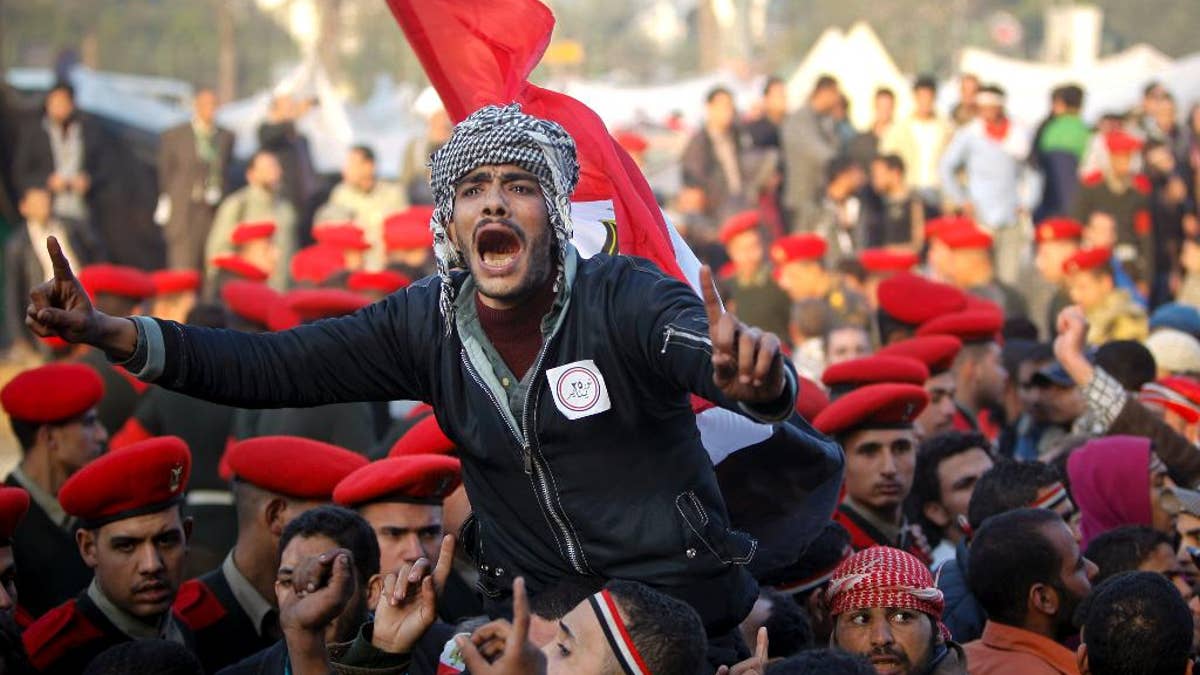
FILE - In this Feb. 13, 2011 file photo, remaining Egyptian protesters shout slogans as they are surrounded by army soldiers trying to lead them away from Tahrir Square in Cairo, Egypt. Within days, a cheering world community was riveted to screens as Egypt's long-submissive people thronged to Cairo's Tahrir Square, braving bullets and refusing to leave until veteran ruler Hosni Mubarak stepped down. (AP Photo/Tara Todras-Whitehill, File) (The Associated Press)
CAIRO – Here's a look at how the countries of the Arab Spring have fared four years after pro-democracy uprisings swept the region:
TUNISIA:
The hope for democratic change that swept the region four years ago is today mainly confined to Tunisia, where the self-immolation of a fruit seller ignited a successful revolt against Zine El Abidine Ben Ali that in turn launched the Arab Spring. Since then Tunisia has held two sets of parliamentary elections and approved a new constitution called the most progressive in the Arab world. Well-organized Islamists initially dominated elections, but when they proved unable to deliver prosperity and stability, they stepped down in favor of a technocratic cabinet and then came in second place to a liberal party in October.
EGYPT:
Egypt captured world attention with its 2011 uprising that ousted longtime dictator Hosni Mubarak. A council of generals took power after Mubarak fell, leading a rocky and often bloody transition in which the Muslim Brotherhood won parliamentary elections. Mohammed Morsi, a veteran Brotherhood leader narrowly elected president in June 2012, was overthrown by the military a year later following massive protests against his divisive rule. Since then security forces have killed hundreds and jailed thousands, and have expanded the crackdown on dissent beyond Islamists to target secular activists, including some of the leading lights of the 2011 uprising. Abdel Fattah el-Sissi, who as military chief led the ouster of Morsi, was elected president this year, and critics say his government is even more oppressive than that of Mubarak, who could soon be released from prison.
BAHRAIN:
Protests in Bahrain began in February 2011, with the tiny island nation's majority Shiites demanding greater rights. The Sunni-led monarchy responded with mass arrests and force. Bahrain's Arab Gulf neighbors, worried about potential spillover effects, quickly sent troops to help quell the uprising. More than 60 people are believed to have been killed in clashes with police over the last four years. Activists say up to 3,000 people remain in jail. Near-daily skirmishes still erupt in Shiite-dominated villages, with some protesters using firearms and homemade bombs against police. National dialogue talks have so far failed, prompting major opposition groups to boycott the 2014 parliamentary elections.
LIBYA:
In Libya, what began as Arab Spring protests rapidly escalated into an eight-month NATO-backed armed revolt that finally led to Moammar Gadhafi's ouster and death, but also left the country in chaos. Successive weak central authorities were forced to rely on a patchwork of militias, many of which have strong tribal, regional or ideological loyalties, while Islamic extremist groups grew. A prolonged power struggle between Islamists and their opponents in the country's first freely elected parliament fueled clashes across the country. Today an Islamist-dominated government convenes in the capital Tripoli, which was captured by allied militias earlier this year, and an internationally-recognized government is confined to the country's far east.
YEMEN:
In 2011, young people launched a sit-in seeking to end President Ali Abdullah Saleh's 33-year rule and transform the poorest Arab nation into a democratic, modern society. The Muslim Brotherhood's branch in Yemen moved in and dominated the protest movement, turning the revolt into a power struggle with Saleh, who stepped down in late 2011 as part of an accord mediated by Gulf nations. Nearly four years later, Yemen is in chaos. Shiite Houthi rebels, marginalized in the deal, have overrun the capital. Saleh remains powerful, with his loyalists infusing the political scene and the military. Al-Qaida's powerful local affiliate has stepped up attacks.
IRAQ:
Thousands of protesters, inspired by events in Tunisia and Egypt, used the momentum in February 2011 to call for an end to corruption and job, power and water shortages. Several dozen reportedly died in clashes with security forces. In response, then-Prime Minister Nouri al-Maliki said he would not seek a third term in 2014 — a promise on which he later reneged. Al-Maliki was forced out in August, in the aftermath of the Islamic State group's capture of much of northern and western Iraq, including the second largest city Mosul.
SYRIA:
By the time Arab Spring protests broke out in Syria in March 2011, President Bashar Assad, having witnessed the humiliating end of other Arab dictators, was determined to crush the uprising at any cost. The brutal government crackdown drove opposition supporters to take up arms, and the conflict has since escalated into one of the most savage civil wars in decades, with no end in sight. One third of the country is now controlled by the extremist Islamic State group. More than 200,000 people have been killed and half the population displaced.
GULF STATES:
Aside from Bahrain, the other Western-backed oil and gas-rich Gulf nations were largely untouched by the Arab Spring. Kings, emirs and sheiks collectively pledged more than $160 billion in 2011 to appease the public while unleashing heavy-handed crackdowns on activists calling for reform. Gulf nations meanwhile gave billions of dollars in aid to various Libyan and Syrian rebel groups, and to the military-backed government in Egypt. Qatar spent billions of dollars propping up Islamists across the region.
MOROCCO:
In Morocco, there has been little progress in implementing constitutional changes meant to expand the democratic spaces in the country, and human rights organizations have even reported a rollback in some of the freedoms gained following mass protests in 2011.
